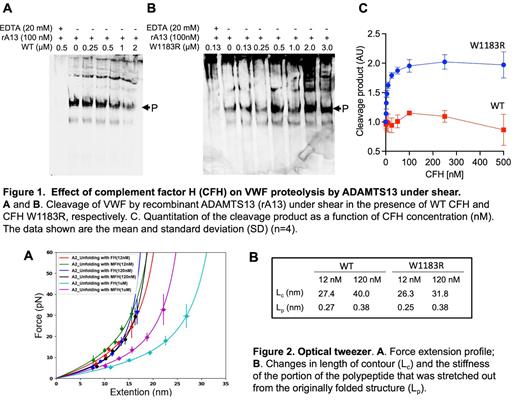Introduction: Complement factor H (CFH) is the primary negative regulator of complement activation in the alternative pathway in both fluidic phase and on cell surface. Loss of function of CFH such as W1183R is associated with atypical hemolytic uremic syndrome (aHUS). Homozygous mutation W1206R in the murine CFH, corresponding to W1183R in human CFH, results in acute aHUS. Interestingly, in these mice, while plasma VWF antigen levels are significantly increased, plasma VWF multimer size is markedly reduced in ADAMTS13-depedent manner. However, the molecular mechanism underlying such a dramatic effect of the mutant CFH (W1206R) on VWF multimer distribution is not known. The goal of this study is to determine how wild type CFH and mutant CFH W1183R affects VWF proteolysis under shear, and the mechanism of action.
Methods: Recombinant WT CFH, CFH W1183R, ADAMTS13, and VWF fragments were expressed in mammalian cells and purified to homogeneity. The effects of WT CFH or CFH W1183R on proteolytic cleavage of VWF73 peptide and full-length multimeric VWF were determined. Additionally, the binding and unfolding events were determined by micro scale thermophoresis (MST) and optical tweezer, respectively.
Results: WT CFH showed no effect on the cleavage of peptide VWF73 substrate, but CFH W1183R enhanced the proteolytic cleavage of VWF73 by ADAMTS13 in a dose-dependent manner ( Fig. 1). Counterintuitively, WT CFH appeared to inhibit the proteolytic cleavage of multimeric VWF by ADAMTS13 under arterial shear, but CFH W1183R exhibited an opposite effect, modestly enhancing the proteolytic cleavage of multimeric VWF by ADAMTS13 under the same conditions. The MST binding assay demonstrated that both WT CFH and CFH W1183R bind to a short A1, a long AIM-A1, and A1-A2-A3 fragments with a dissociation constant ( K D) of 6.4 x 10 -7, 3.0 x 10 -9 M, and 3.3 x10 -9 mol/L, respectively. These results suggest that CFH may bind to the AIM, A1-A2 junction, and A2 domain. To further assess the impact of CFH binding to A2, we performed optical tweezer experiments. The results showed that both WT CFH (Lc: from 27.4 nm at 12 nM to 40 nm at 1.0 mM) and CFH W1183R (Lc: from 26 nm at 12 nM to 31.8 nm at 1.0 mM) resulted in significantly extended contour length (Lc) of VWF-A2 domain in a concentration-dependent manner ( Fig. 2), suggesting a dramatic conformational change in the A2 domain upon binding by WT CFH or CFH W1183R.
Conclusions: Our results demonstrate that WT CFH at physiological concentrations may exhibit a modest inhibitory activity towards cleavage of VWF by ADAMTS13 under shear, but such an inhibitory activity disappears as the result of a point mutation in the C-terminal end of CFH (e.g., W1183R). Instead, the mutant CFH W1183R appears to enhance the VWF cleavage by ADAMTS13, likely through direct binding to the AIM, A1-A2 junction, and A2 domain of VWF, resulting in conformational changes in the central A2 domain.
Disclosures
Zheng:Sanofi: Consultancy, Honoraria; Apollo: Consultancy, Honoraria; Clotsolution: Other: Co-founder; GC Biopharma: Consultancy, Honoraria; Stago: Consultancy, Honoraria; TAKEDA: Consultancy, Honoraria.


